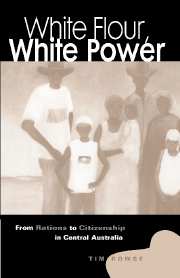8 - The Crisis of Managed Consumption
from PART THREE
Published online by Cambridge University Press: 23 October 2009
Summary
The 1965 equal wages case was of great importance in the transition from rations to cash. In 1963 and again in 1965, the Australian Council of Trade Unions (ACTU), in keeping with assimilation policy, resolved that all Indigenous Australians should be covered by statutory industrial awards. In 1965, the Northern Australian Workers' Union (NAWU) applied to the Commonwealth Conciliation and Arbitration Commission to delete words excluding Indigenous workers from the Cattle Station Industry (Northern Territory) Award. The Full Bench of the Commission, after hearing evidence for and against this change, ruled in the NAWU's favour. By 1 December 1968, all male Indigenous employees on Northern Territory cattle stations were entitled to the award.
The quasi-settlements
At that time, the distribution of Indigenous people among Central Australian pastoral leases was uneven (see Table 8). One in three leases did without any resident Indigenous community in 1965–6. Just under half accommodated the numbers to make up a small stock camp and their dependants. Almost a quarter of leases had more than the numbers for a basic stock camp. The ten biggest station camps in 1965–6 accommodated 973 Aborigines, according to one Administration count; that is, 12% of leases accounted for 59% of the Giles district's Aboriginal residents of cattle stations.
Comparing the 1965–6 enumeration of these ten leases with midcentury counts (Table 9), we find that almost every station camp had grown.
These large station camps could be described as ‘quasi-settlements’, made possible by government subsidy.
- Type
- Chapter
- Information
- White Flour, White PowerFrom Rations to Citizenship in Central Australia, pp. 118 - 146Publisher: Cambridge University PressPrint publication year: 1998



